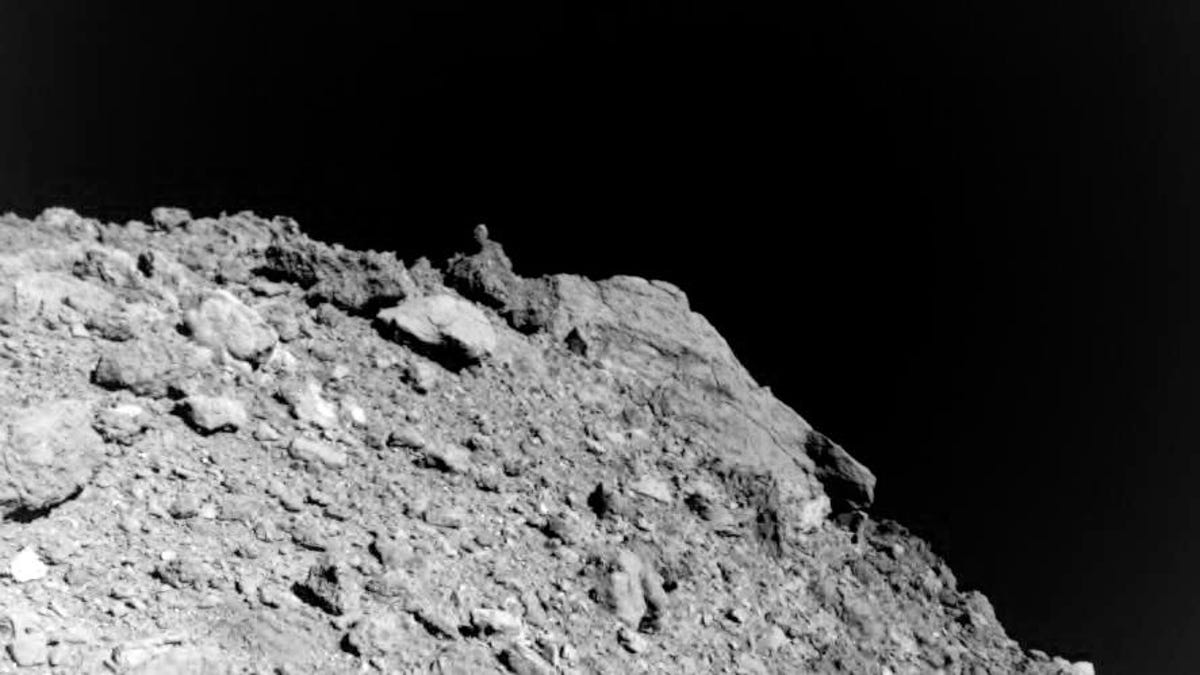Unexpected discovery on the surface of asteroid Ryugu intrigues scientists
Scientists expected to see fine particles and dust on the surface of the near-Earth asteroid.

Ryugu's surface is not as dusty as expected.
The dull gray boulders that glow against the black curtain of space in the image above don't look all that impressive. But the rocks are giving scientists a new way to look at near-Earth asteroid Ryugu. In October 2018, a small lander known as Mascot, was dropped on the asteroid by Japan's Hayabusa2 spacecraft as it tailed Ryugu, around 186 million miles (300 million kilometers) from Earth.
After imaging the surface, the lander has revealed some unexpected results: Ryugu is not as dusty as scientists expected.
That result was published in the journal Science on Thursday in a study that examined data and images from Mascot, which is short for Mobile Asteroid Surface Scout. The box-shaped lander was dropped onto Ryugu on Oct. 3, 2018, and was able to "tumble" across its surface, snapping pictures along the way with its specialized camera, dubbed MASCam.
The team tracked Mascot's movements after it was deployed by Hayabusa2, tracing its positions across Ryugu's surface. Being basically a box with a camera and some fancy LED lights, the robot is mostly immobile but it can use an internal lever to flip itself a short distance. Immediately after descent, Mascot was in a bad way. Like a turtle flipped on its back, the MAScam was pointing up at empty space and could only image the sky. But on the second day, the internal lever inside Mascot flipped the robot over so it could image the asteroid's surface during day and night. (Ryugu makes a complete rotation every 7 hours and 38 minutes and orbits the sun once every 474 days.)
Researchers from the German Aerospace Center, also known as DLR, and collaborators in France and Japan, studied images from MASCam once it had settled into position and identified two types of rock -- "dark and rough" and "bright and smooth" -- that range in size from 10 centimeters (about 4 inches) to tens of meters. The rocks are distributed evenly across Ryugu's surface, which is consistent with earlier observations published in Science suggesting Ryugu probably formed after a catastrophic collision.
When darkness fell over the asteroid at night, Mascot flicked on its LED lights and continued to snap images. That helped the team discover sparkling "inclusions," or tiny pieces of material embedded in the rock. That could suggest Ryugu is similar to carbonaceous chondrites, a type of meteorite believed to originate in the early solar system also known to contain inclusions.
"The multispectral images indicate relative primitive and primordial surface material pointing back to the early formation of the solar system," says Ralf Jaumann, who led the study.
It would be nice if my apartment was as dust-free as this.
In addition, the ability to detect inclusions on a space rock hundreds of millions of miles from Earth led the team to believe the boulders on Ryugu's surface were not covered in fine particles or dust.
That's a little unusual.
The research team writes "we expect dust to be formed continuously on the surface of Ryugu through exposure to the space environment." Therefore, Ryugu must have a mechanism that clears the dust from the surface. That mechanism is currently unknown.
"One explanation could be the charging of fine dust particles due to solar radiation and their subsequent removal via electrical forces," Jaumann explains. "It is also possible that out-gassing of volatiles could have removed the dust or that shaking within the asteroid could move preferentially small particles into the interior."
Hayabusa2 will land one more exploration robot, Minerva-II2, on the surface of Ryugu later this year. Once its science operations are complete, the spacecraft will depart the asteroid and head toward Earth. When it rendezvouses with home in 2020, it will drop off a capsule of samples it picked up after blowing a hole in the side of Ryugu. If all goes as planned, the retrieved rock will reveal more about its origins and the early solar system.
Update 4:23 p.m. PT: Adds researcher comments.

